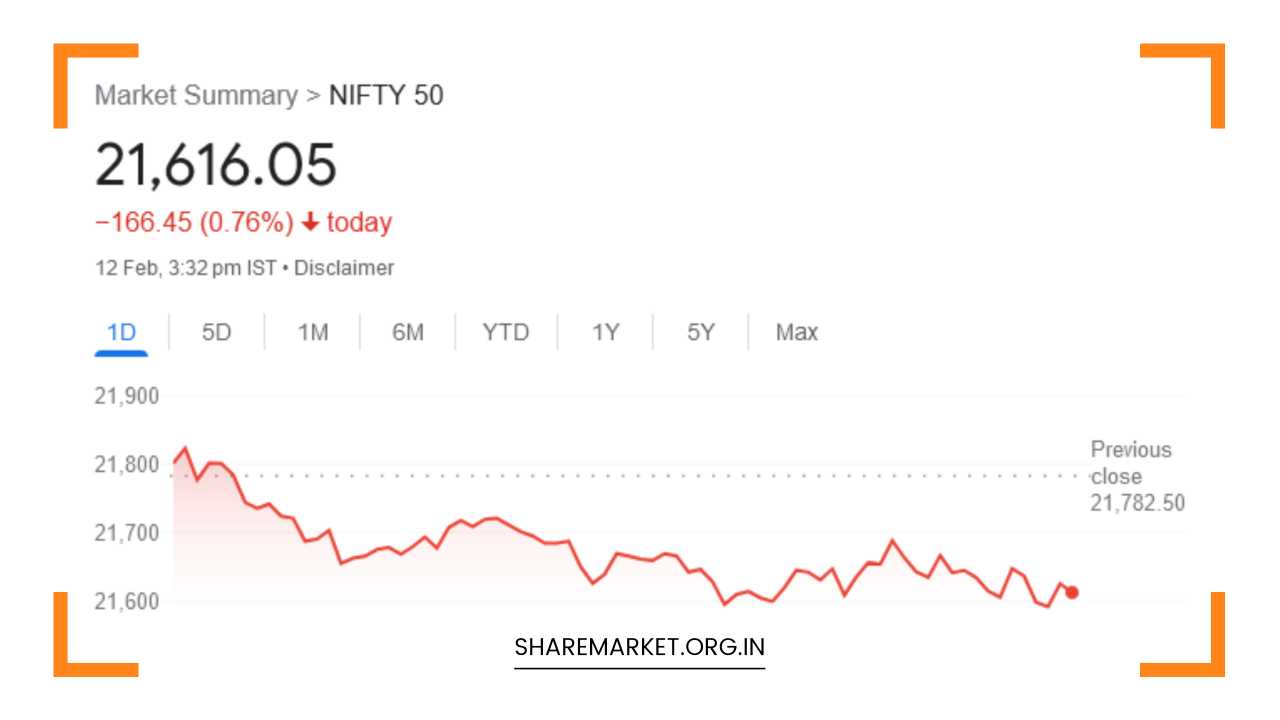Nifty Ends Near 21600; Nifty Prediction for Tomorrow

Nifty Prediction for Tomorrow
Market Analysis and Stock Performance: Unraveling Trends and Expert Insights
The financial markets, particularly the Nifty index, have been subject to notable fluctuations, as indicated by the breakdown of consolidation on the hourly chart.
This downward trajectory is indicative of growing market weakness, a sentiment underscored by the Nifty’s position at a relatively low level on the daily chart.
On February 12, the Indian stock market witnessed a pervasive sell-off across most sectors, with the exception of IT and Pharma. This widespread selling activity led to the closure of the Nifty at around 21,600.
Meanwhile, the Sensex experienced a decline of 523 points or 0.73 percent, closing at 71,072.49. Market dynamics on this day were reflected in the performance of individual stocks, with 791 shares posting gains, 2618 experiencing declines, and 66 remaining unchanged.
Notably, the BSE Midcap index and Smallcap index fell by 2.6 percent and 3 percent, respectively.
Among the top Nifty losers were prominent names such as Coal India, Hero MotoCorp, BPCL, ONGC, and NTPC.
Conversely, leading the gainers on the Nifty were Dr Reddy’s Laboratories, Apollo Hospitals, Wipro, Divis Labs, and HCL Technologies.
A sector-wise breakdown revealed declines ranging from 1-4 percent in FMCG, PSU Bank, Capital Goods, Metal, Oil and Gas, Power, and Realty. In contrast, Health Services and IT indices managed to close in positive territory.
Insights from Market Experts:
Vinod Nair, a financial expert at Geojit Financial Services, attributed the reduction in market positions to an increase in exchange margin requirements.
Notably, there was a more pronounced decline in mid and small-cap stocks. The selling trend cut across various sectors, except for pharma and IT, with PSU banks experiencing the maximum weakness.
Nair expressed concern about the widening premium valuation gap between mid and large caps, which has now reached an all-time high.
Despite optimistic economic forecasts, the anticipation of slowing corporate earnings, attributed to weak operating margins, poses a challenge to maintaining premium valuations for the broader market.
In Nair’s view, large-cap stocks may emerge as frontrunners amid market consolidation.
Technical Analysis and Market Indicators:
Rupak Dey, an analyst from LKP Securities, delved into the technical aspects of Nifty’s performance. Dey emphasized that the breach in consolidation on the hourly chart signifies an intensifying bearish sentiment.
This bearish outlook is further corroborated by the daily chart, which places Nifty at a low level, indicating a decrease in bullish sentiment.
Momentum indicators align with the bearish outlook, suggesting the potential for continued selling as long as Nifty remains below the critical level of 21,850. On the downside, support is identified at 21,500.
Kunal Shah, also from LKP Securities, provided insights into the dynamics of the Bank Nifty index. According to Shah, bears continued to dominate the Bank Nifty, with evident pressure at upper levels.
A close below the short-term support level of 45,000 is seen as a clear signal of bearish sentiment. Immediate resistance is identified at 45,100, and breaching this level could trigger short-covering towards 45,500.
Conversely, immediate support is visible at 44,800, and a failure to hold this support might lead to an escalation of selling pressure towards 44,000 points.
Macro-economic Factors and Market Sentiment:
Beyond technical indicators, macro-economic factors play a crucial role in shaping market sentiment. The ongoing reduction in positions is associated with the increase in exchange margin requirements, pointing to the impact of regulatory changes on market behavior.
The decline in mid and small-cap stocks suggests a risk-off sentiment among investors, possibly driven by uncertainties in the broader economic landscape.
Despite robust economic forecasts, there is a looming concern about the slowdown in corporate earnings. The weak operating margins are identified as a key factor contributing to this apprehension.
This poses a challenge to maintaining premium valuations in the broader market, especially as the premium valuation gap between mid and large caps has reached unprecedented levels.
Sector-wise Performance:
A closer look at sector-wise performance reveals a diverse landscape. The FMCG, PSU Bank, Capital Goods, Metal, Oil and Gas, Power, and Realty sectors all experienced declines ranging from 1-4 percent.
This broad-based decline indicates a systemic issue rather than sector-specific challenges. On the positive side, the Health Services and IT indices managed to buck the trend, closing in the green. This divergence in performance highlights the selective nature of investor confidence during this period.
Investment Strategy amid Consolidation:
Considering the prevailing market conditions, market experts are formulating investment strategies to navigate the consolidation phase.
Vinod Nair suggests that large-cap stocks might offer a more resilient investment option amid market consolidation.
However, challenges persist, especially with the premium valuation gap widening. Investors need to carefully weigh the potential returns against the heightened risks associated with the current market environment.
Final Thoughts:
In conclusion, the recent market trends and expert insights paint a nuanced picture of the financial landscape. The breakdown of consolidation on the hourly chart, coupled with the downward trajectory on the daily chart, signals a period of increased market weakness.
The sell-off on February 12, affecting most sectors except IT and Pharma, underscores the challenges facing investors in the current market environment.
The insights from market experts, technical analyses, and macro-economic factors collectively highlight the need for a cautious and strategic approach.
While large-cap stocks may offer relative stability, the broader market’s premium valuation challenge and the uncertainties in corporate earnings growth necessitate a thorough evaluation of risk and return dynamics.
Investors and market participants are advised to stay informed, monitor key technical levels, and adapt their strategies to navigate the evolving market landscape.

















